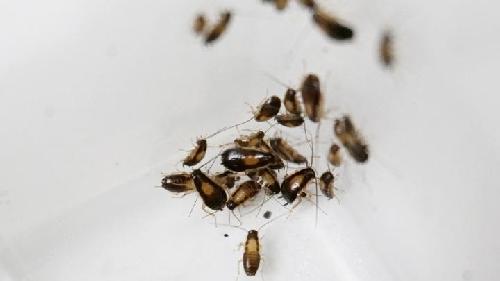North Carolina State University research shows that bacteria in the gut of German cockroaches play a major role in how the cockroaches gather together, or aggregate. The findings could lead to more efficient roach baits and traps.
In a study published in the Proceedings of the National Academy of Sciences, NC State entomologists show that roach gut bacteria produce a wide variety of fatty acids that contribute to production of pheromones in roach feces. These fecal pheromones serve as a type of welcoming scent that attracts other roaches.
Lead author Ayako Wada-Katsumata, an NC State senior researcher, and corresponding author Coby Schal, Blanton J. Whitmire Distinguished Professor of Structural Pest Management, show that roaches won't aggregate when there is no welcoming scent - when they encounter feces without the chemical compounds produced by gut bacteria.
 This is an aggregation of German cockroach nymphs. Gut bacteria play an important role in how roaches gather together, according to new research published in PNAS. Credit: Ayako Wada-Katsumata, NC State University
This is an aggregation of German cockroach nymphs. Gut bacteria play an important role in how roaches gather together, according to new research published in PNAS. Credit: Ayako Wada-Katsumata, NC State University
In the study, the researchers found 40 different chemical compounds in the feces of German cockroaches, but the feces of roaches without gut bacteria lacked 12 of these compounds and had only miniscule amounts of 24 of the other compounds.
"When you lose the gut bacteria, you lose the aggregation pheromones," Schal said.
The researchers tested newborn roaches, or nymphs, and older roaches both individually and in groups and found essentially the same result - aggregation when the chemical compounds were present in feces and little to no aggregation when those chemicals were absent or in low concentrations.
"The chemical compounds seem especially essential for nymphs," Wada-Katsumata said. "It's important for nymphs to determine a safe place, and these pheromones help do just that."
The study also used gas chromatography and mass spectrometry to identify the most attractive of the 40 chemicals present in the feces. Six particular compounds were the strongest attractants for the NC State roaches - stronger than a patented blend of attractant compounds developed elsewhere, in fact.
"Aggregation pheromones may drive colony fidelity," Schal said. "Different gut bacteria create different chemical profiles of aggregation pheromones, but many of these compounds overlap, depending on the food available to roaches. This suggests that aggregation is plastic, as compounds can be mixed and matched for different groups of roaches, depending on their environment."
source: North Carolina State University